The Enchantment of Glass Beaches: Nature's Creation
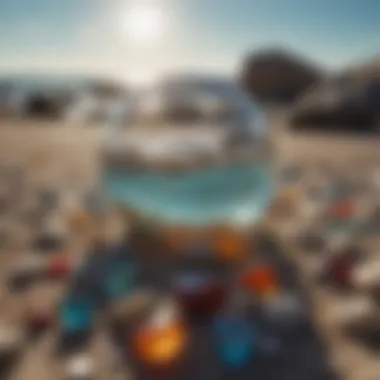

Intro
Glass beaches are captivating places where the remnants of human activity meet the forces of nature, giving birth to a unique landscape. These beaches, often dotted with smooth, colorful pieces of glass, invite visitors not just for their beauty but also for a chance to connect with a deeper ecological narrative. This phenomenon occurs when discarded glass items are ground down by waves and tides, transforming them into beautifully polished fragments over time.
While the alluring sight of glimmering glass against the backdrop of the ocean is enough to capture anyone's attention, there’s a significant story beneath the surface. Understanding how these beaches formed, the importance of their ecosystems, and the various cultural influences tied to them can enrich our appreciation and sense of responsibility towards such natural wonders. Moreover, as tourism increases in these delicate environments, sustainable practices are vital to ensure that both nature and human enjoyment can coexist harmoniously.
As we journey through this exploration, visitors and collectors alike will uncover not just the superficial beauty of glass beaches but also the intricate layers of history and ecology that form the backbone of these sparkling shorelines. The following sections will shine a light on both the stunning and the essential aspects of these dynamic ecosystems.
Prologue to the Beach of Glass
The unique and captivating phenomenon known as the beach of glass does more than just dazzle the eye; it opens up a realm of understanding about our planet and its history. This article highlights the significance of these stunning landscapes, encompassing both their geological attributes and their cultural relevance. The allure of glass beaches is not just about their beauty but also centers on the processes that led to their formation and the ecosystems they support. Recognizing these aspects allows rock and fossil collectors, or anyone curious about natural history, to appreciate the intricate interplay between nature and human influence.
Understanding the Concept
At a glance, a beach of glass may seem like a whimsical creation, but there’s much more beneath the shiny surface. These beaches emerge from the natural weathering of glass—often discarded bottles and containers—that are tumbled by the relentless waves over years, sometimes decades. The transformation occurs as the harsh elements break down the sharp edges and surfaces, turning them into smooth, vibrant pebbles that sparkle in the sunlight. This process presents a clear narrative of the past and serves as a reminder of human impact on nature.
The concept extends beyond mere aesthetics; it questions our relationship with waste and its ecological footprint. How does something that began as litter now function as a marvel of nature? By understanding the dynamics at play, individuals can grasp the intricacies of environmental stewardship and the importance of preserving such habitats.
Geological Significance
From a geological perspective, glass beaches provide an important case study about sediment dynamics and coastal processes. Often formed in areas where there is significant erosion, these beaches can alter local geological formations all around them. The smooth pieces of glass, often in a variety of colors, can showcase the geological history of the region, revealing information about human activity and the materials that have made their way to the shoreline.
"The beauty of glass beaches lies as much in their creation story as in their appearance."
Beyond that, these unique landscapes also reflect essential geological concepts like sediment transport and marine erosion. They often serve as natural laboratories for scientists studying the consequences of plastic and glass waste in our environment.
Understanding the geological background of these beaches enriches the conversation about their significance. It encourages deeper thinking regarding conservation efforts and ecological management, ultimately bridging the gap between natural beauty and scientific inquiry.
Overall, the beach of glass stands not just as a striking destination but also as a 'masterpiece' of nature, woven from the threads of our history, emphasizing the transformative processes that shape our coastlines.
Formation of Glass Beaches
The world of glass beaches is one painted with vivid colors and intricate stories told by nature itself. The formation of these unique coastal wonders is not just a spectacle; it holds deep implications for geological study and environmental awareness. To understand why these beaches draw both curiosity and appreciation, it’s essential to explore the processes that bring them into existence and the factors that influence their development and sustainability.
Natural Processes Involved
The remarkable phenomenon of glass beaches begins with ordinary materials—sand, pebbles, and bits of glass. Over time, these components undergo a transformation that reveals nature's craftsmanship. The glass, often a remnant of human activity, can be swept into coastal areas through various means but primarily comes from the ocean's powerful waves.
- Erosion: As waves crash against cliffs or banks, they break down materials. Erosion plays a key role, smoothing sharp edges and turning shards of glass into smaller, polished pieces. The relentless action of water acting against rock formations is akin to a sculptor chiseling away rock to reveal a statue beneath.
- Transportation: This involves the movement of these glass pieces along the shoreline. The undertow can shift them, ensuring they don't just settle but rather continue to change shape through constant abrasion.
- Deposition: Eventually, these glassy morsels find a resting spot, leading to the iconic beaches filled with shimmering, colorful polished glass. This process often results in varied textures and appearances—some beaches exhibit brilliant, multicolored glass, while others might present more muted tones, depending on the composition and types of glass involved.
Adding to this natural artistry, the beach environment itself, with its unique wind patterns and tidal systems, further contributes to the formation of glass beaches. These natural elements offer a dynamic stage where geological processes play out, showcasing the interplay of water, land, and time.
Human Impact and Contribution
The creation of glass beaches is as much a human story as it is a natural one. While nature shapes these landscapes, human activity—often unwittingly—contributes significantly to their formation. The places where these beaches flourish often serve as a testament to both our ingenuity and our carelessness.
- Historical Dumping Grounds: Many glass beaches originated from sites where glass was discarded. Old glass bottles, windows, and other items—normally considered waste—found their way to these coastal areas, creating the material for future beaches. For example, the famous Glass Beach in Fort Bragg, California, was once a dumping site that has since burgeoned into a vibrant, environmentally reclaimed area.
- Recycling Initiatives: Only recently have some communities turned toward sustainable practices, bringing focus to reusing and recycling glass materials instead of discarding them. Local efforts encourage the collection of glass to repurpose it into art or functional items, hinting at a more responsible future moving forward.
- Tourism Effects: The sheer beauty of glass beaches attracts visitors, and with them comes the risk of pollution and erosion. The delicate balance between enjoying these stunning locales and maintaining their integrity is shaky and requires thoughtful tourism management.
In essence, the formation of glass beaches illustrates the continuum of interaction between humans and nature. It offers lessons about waste, sustainability, and the delicate interplay that can lead to not only beauty but also ecological fragility.
"Glass beaches remind us of our past actions and the potential for redemption in nature’s hands."
Through understanding these processes, we can appreciate the artistry in our interactions with the environment and strive to protect these masterpieces for generations to come.

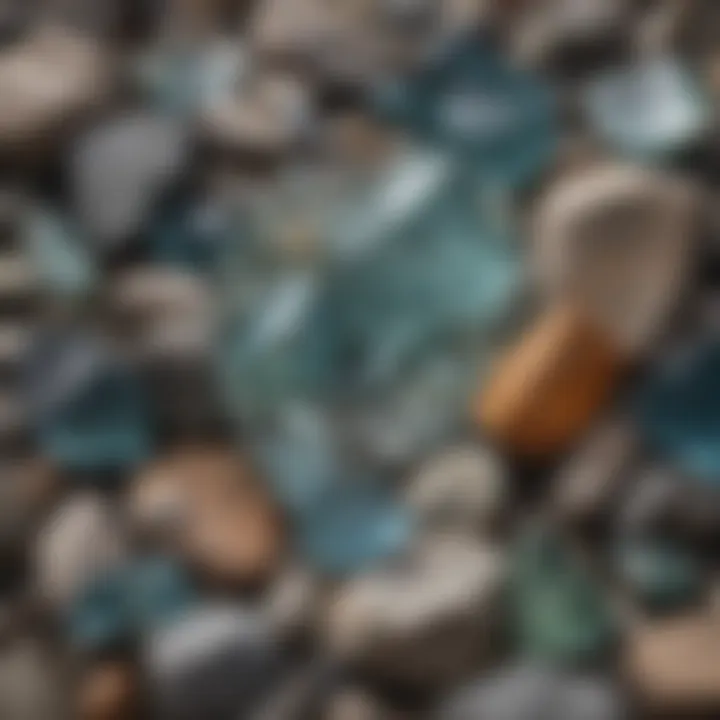
Ecological Importance
The ecological significance of beaches made of glass stretches beyond their stunning aesthetics. These unique landscapes, often formed from human activity, have developed into ecosystems that support various forms of life and contribute to environmental health. Understanding their ecological importance provides insight into the intricate relationships between marine life, coastal dynamics, and geological processes.
Supporting Marine Life
Glass beaches serve as unexpected habitats for marine organisms. The smooth, rounded pieces of glass can create microhabitats for small fish, crabs, and various invertebrates. For instance, juvenile fish often seek shelter in the nooks and crannies created by larger pieces of glass. The reflective surfaces can also attract algae, which plays a crucial part in the marine food web.
"Each piece of glass carries its own story, transformed by waves into a safe haven for critters that might otherwise go unnoticed."
In essence, these beaches become a nurturing ground, promoting biodiversity along the coast. Moreover, the unique chemical composition of the glass helps foster a rogue community of microorganisms that further enriches the habitat. This entanglement of life demonstrates how seemingly lifeless objects, like discarded bottles and fragments, can revitalize marine ecosystems.
Influence on Coastal Ecosystems
The presence of glass on the beach influences coastal ecosystems in surprising ways. Firstly, the glass pieces can impede erosion. As they blanket the shore, they mitigate wave action against the sediment beneath them, which helps stabilize the shore and protect other plant and animal life.
The interaction between glass and the local flora shouldn’t be overlooked either. Specific grasses and plants adapt to thrive alongside the glass bits, forming a symbiotic relationship that enhances beach aesthetics while also securing soil layers. Such interactions showcase the interconnectedness of life forms in coastal environments.
Role in Sediment Dynamics
Sediment dynamics on glass beaches behave differently than traditional sandy shores. Glass fragments tend to remain in place, contributing to what is known as sediment trapping. This characteristic can lead to changes in water flow and nutrient distribution along the coast.
Additionally, these altered dynamics create new opportunities for sediment transportation, leading to the formation of accumulations that can disrupt existing coastal formations. Over time, this can attract more marine life and ensure a continuous cycle of growth and decay.
Notable Beaches of Glass
The beaches of glass are not just stunning sights; they are treasure troves of geological history and cultural narratives. Their significance extends far beyond their visual charm, as they serve as living reminders of both the Earth’s natural processes and human influence. These unique beaches present opportunities for research, education, and tourism, attracting rock and fossil collectors who seek to connect with nature’s artistry. Notable beaches of glass have become emblematic of regions, encapsulating the stories of their formation, ecological roles, and cultural meaning.
Famous Examples Around the World
Let's take a closer look at a few famous beaches of glass across the globe, each with its own tale to tell:
- Glass Beach, Fort Bragg, California: This beach is perhaps the most celebrated of them all. Originating from years of dumping broken glass and debris into the ocean, natural processes of erosion have smoothed the shards into colorful pebbles that dazzle in the sunlight. The beach embodies the transformation of waste into beauty, attracting those with a keen eye for unique stones.
- Shattered Glass Beach, Japan: Located in the Izu Peninsula, this pristine beach showcases captivating fragments of glass that have washed ashore, mingling with pebbles and marine life. The blend of colors is tranquil, yet the beach serves as a reminder of human activity.
- Glass Beach, Ewa Beach, Hawaii: Here, the vivid colors of the glass pieces stand out against the landscape of black volcanic rock. The beach once served as a dumping ground, but it has since transformed into an attractive site for visitors looking for natural beauty and geological wonders.
This array of beaches presents not only aesthetic appeal but also raises awareness of the harmony between nature’s power and anthropogenic influences.
Unique Features of Each Location
Diving deeper, each notable beach of glass holds unique characteristics that make visits worthwhile:
- Fort Bragg’s Glass Beach: Visitors are greeted by a vibrant spectrum of colors. The translucent greens, rich ambers, and sparkling whites showcase how human detritus was reshaped by time and tide. Walking along this beach can feel like exploring a natural art gallery, with every footstep revealing still more luminous gems.
- Japan’s Shattered Glass Beach: Unlike its Californian counterpart, the glass here appears against a backdrop of delicate marine landscapes. Nestled between cliffs and lush greenery, it’s a serene place for reflection and observation. Rich in local history, legends speak of the spirits of the ocean, melding culture with the natural elements of glass.
- Ewa Beach in Hawaii: This locale offers a unique interplay with volcanic rock that creates a striking contrast to the glass fragments. Additionally, the beach is less frequented, allowing for a quiet exploration, conducive to the practice of rock and fossil collection. Here, one can sense the delicate balance of elements in the ongoing geological dance of erosion and deposition.
Each of these locales teaches us about resilience, adaptation, and the intricate narratives of both Earth and humanity. In visiting these beaches of glass, collectors not only find treasures but also grapple with the concepts of waste, creation, and the complex ties that bind us to our environment.
Cultural Significance
The cultural significance of glass beaches extends beyond their dramatic appearance. These unique sandy shores tell stories of interaction between humanity and nature, reflecting both the beauty and the scars left by our activities. From centuries of coastal erosion to the remnants of human existence washed ashore, the glass beaches serve as poignant reminders of our relationship with the planet. This aspect is especially critical for rock and fossil collectors as they often find not just geological treasures but also historical artifacts on these beaches.
Historical Context
Glass beaches were not always captivating landscapes. They often originated from the remnants of discarded items thrown away without a second thought. Over time, coastal processes transformed glass shards—previously unsightly litter—into beautifully polished gems. History shows us that places like Fort Bragg’s Glass Beach started as dumps for industrial waste. The gradual erosion by waves smoothed and shaped the discarded glass, turning it into something enchanting.
This transformation speaks volumes about how communities can evolve from neglect to preservation. In many ways, it highlights a social awareness that has intensified in recent decades. People are recognizing the aesthetic and cultural value of oddities shaped by time and ecological conditions. Each piece of glass found on these shores carries its own history, much like every rock holds memories of Earth’s ancient past.
Artistic Interpretations
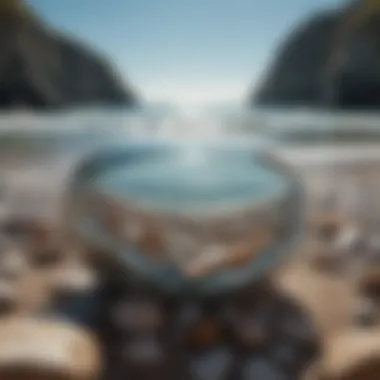
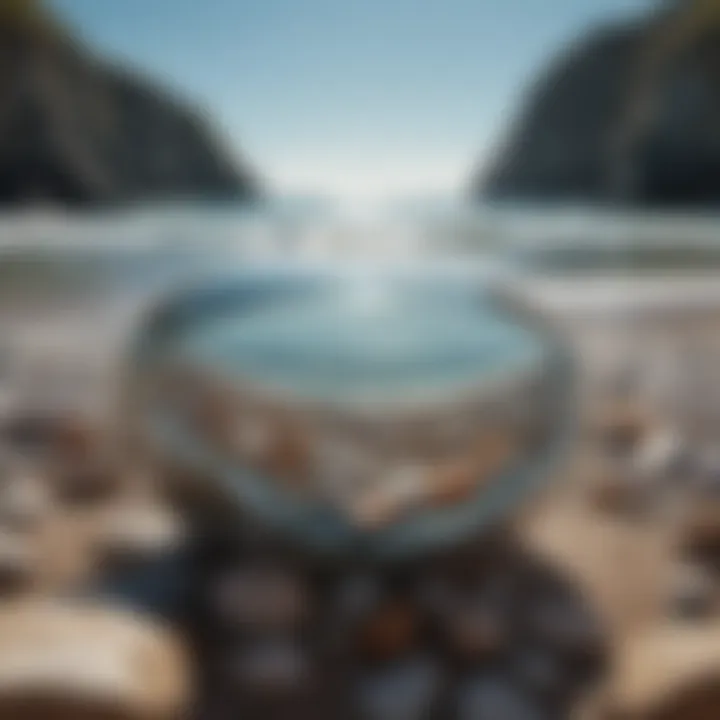
The allure of glass beaches has also filtered into the world of art. Artists and designers have embraced the natural beauty of these beaches, seeing not just trash but potential. Artists use the unique textures, colors, and forms of the glass to create sculptures, jewelry, and other forms of art that celebrate both nature and the stories these remnants tell.
Some community projects have involved locals collecting glass in a sustainable way, turning it into art as a method of raising awareness about environmental issues. This intertwining of art and ecology forms a unique dialogue, making the glass not merely an object but a medium of storytelling. Collectors and casual visitors alike may find themselves not only admiring the beauty of the glass but also contemplating the broader implications of human impact on nature.
"Every piece of colored glass is a tiny portal to the past, whispering tales of a time long gone."
In summary, the cultural significance of glass beaches lies in their ability to connect people to the environment through history and art. For collectors and enthusiasts, these shores present a fascinating intersection of fossilized human actions and the raw beauty of marine geology. The myriad experiences and histories captured in each shard turn these beaches into more than mere destinations; they become a celebration of life, transformation, and the eternal dance between humanity and nature.
Tourism and Visitor Experience
The serene and captivating allure of glass beaches draws numerous visitors each year. This unique phenomenon offers travelers a chance to not only enjoy stunning landscapes but also gain insights into geological and ecological processes. For rock and fossil enthusiasts, these beaches serve as a veritable treasure trove, teeming with vibrant bits of sea-polished glass that catch the light ever so beautifully.
As visitors arrive at these locations, they’ll find an array of activities that cater to their interests. Whether it’s collecting smooth, colorful pieces of glass or simply soaking up the sun on shores that shimmer and glimmer, the experience is rich and varied. Each unique beach has its own charm, fostering a deeper appreciation for nature’s artistry. Understanding the significance of these sites encourages visitors to respect and protect them, ensuring their preservation for future generations.
Popular Activities
When visiting a glass beach, there's no shortage of activities to engage in. Here are some popular pursuits that visitors enjoy:
- Glass Collecting: The most common activity, where people search the shores for pieces of sea glass. Collectors often look for specific colors or shapes to add to their collections.
- Photography: The visual aesthetic of glass beaches presents stunning opportunities for photographers, whether hobbyist or professional. Capturing the colors and textures of the glass against the backdrop of the ocean creates truly mesmerizing images.
- Walking and Hiking: Many beaches are surrounded by scenic trails that provide breathtaking views of the coastline. Walking allows visitors to appreciate nature’s beauty up close.
- Learning Tours: Guided tours that educate visitors about the geological processes that lead to the formation of glass beaches can be quite eye-opening. Knowledgeable guides share insights about the history and environmental importance of these locations.
Visitor Guidelines and Best Practices
As glass beaches face increasing foot traffic from tourists, it's crucial for visitors to uphold certain guidelines to safeguard these delicate environments. Here are some best practices:
- Leave No Trace: Visitors should avoid leaving trash, including organic waste, on the beach. Carrying out whatever is brought in is essential to maintaining the pristine condition of these areas.
- Do Not Harvest Excessively: While collecting glass is part of the experience, taking too much can deplete the beach of its natural beauty. It’s wise to limit what you take home and leave enough for others to enjoy.
- Respect Wildlife: Many glass beaches are also habitats for various marine animals. Observing wildlife from a distance and avoiding disturbing their natural habitat is important.
- Follow Local Regulations: Every location might have specific rules regarding collecting or accessing certain areas. It’s wise to familiarize yourself with these regulations to avoid fines and ensure the protection of the beach.
"Every piece of glass has a story; collecting responsibly ensures those stories continue to be told."
By adhering to these guidelines, visitors can enjoy their experience while preserving the natural beauty of glass beaches. Engaging in responsible tourism plays a key role in ensuring these stunning landscapes can be appreciated for years to come, not just by us but also by future generations.
Conservation Challenges
Conservation challenges for glass beaches are paramount as they confront both environmental and human-driven factors that threaten their unique ecosystems. These beaches, formed from millions of years' worth of geological processes intertwined with human impact, face an uncertain future as development and pollution dictates their landscapes. Acknowledging these challenges shines a light on why proactive conservation efforts are needed to cherish and protect these natural enigmas.
Through understanding these struggles, stakeholders can better collaborate and find pathways to maintain the delicate balance between tourism and ecological integrity.
Environmental Threats
The environment around glass beaches is under siege from a range of threats that can unravel the intricate balance of their ecosystems.
- Pollution: Urban runoff, litter, and plastics are prevalent throughout coastal regions, filtering into these fragile areas, drastically altering their natural state. Contaminants degrade not only the aesthetic appeal but also the health of the local marine life that calls these beaches home.
- Climate Change: Rising sea levels and unpredictable weather patterns threaten the very existence of glass beaches. As coastlines erode, the organic formation of these glassy shores can diminish, leaving less habitat for marine organisms.
- Destructive Natural Events: Hurricanes, storms, and other climatic extremes can ravage glass beaches, displacing sediments, and potentially altering their unique makeup. The aftermath of such events often leads to longer recovery times, stifling the native species' revival.
"The preservation of glass beaches is not just about protecting a pretty coastline; it's about maintaining a network of life that depends on these intricate environments."
Human Activities Impacting Glass Beaches
The influence of humans on glass beaches is complex and often detrimental. While tourism may provide economic benefits, it also brings challenges that can overwhelm these delicate ecosystems.
- Overtourism: Popular glass beaches, such as those in California and other coastal hotspots, attract hoards of visitors. This surge can lead to erosion, littering, and disturbances to local wildlife. A balance must be struck so that enjoyment doesn't lead to damage.
- Beachfront Development: Construction near glass beaches often brings harmful alterations to coastal ecosystems. Building structures can obstruct natural processes like sand delivery and water filtration, which are vital for sustaining the dynamic environment of glass beaches.
- Unsustainable Collecting Practices: Some enthusiasts collect glass pebbles, treating them more like souvenirs than part of an ecosystem. This kind of gathering can deplete natural resources, disrupting the aesthetics and ecological stability of these shores.
Conservation Efforts
The preservation of glass beaches is an essential topic that demands significant focus. As unique ecosystems, these locales embody the intersection of natural processes and human influence. Thus, conservation efforts encompass more than just maintaining the aesthetic charm of glass beaches; they serve a broader purpose of safeguarding biodiversity, maintaining coastal integrity, and educating communities. The balance between enjoying these natural wonders and protecting them is delicate, making conservation crucial.
Community Engagement
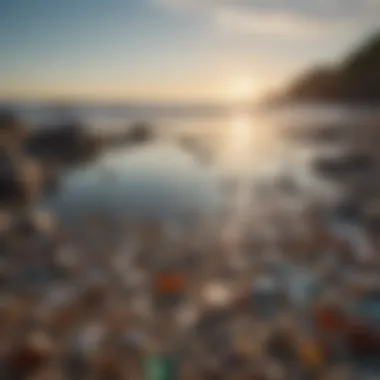
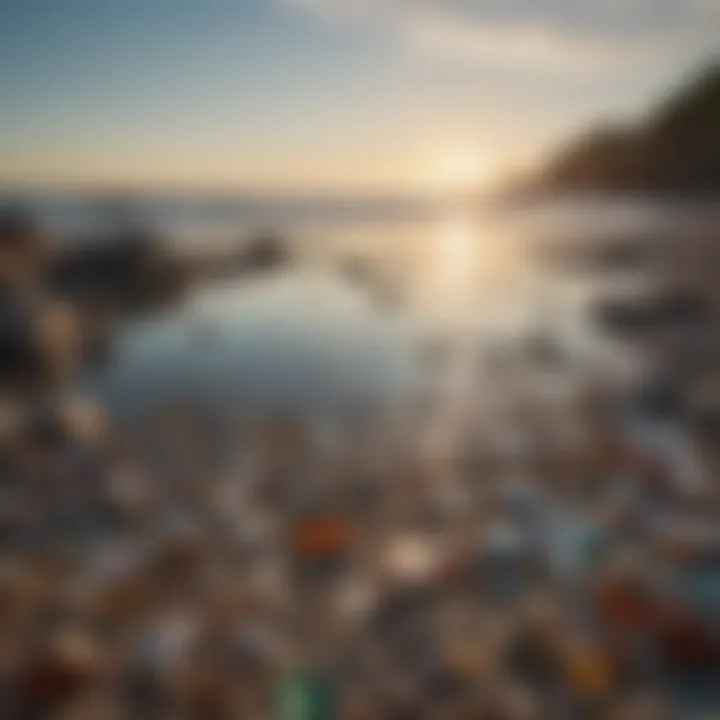
Community engagement plays a vital role in the conservation of glass beaches. Local populations are often the first line of defense against environmental threats and can significantly influence the success of conservation initiatives.
- Local Awareness: Educating the community about the ecological significance of glass beaches is pivotal. Through workshops, beach clean-ups, and educational campaigns, locals can gain a deeper appreciation for their natural surroundings.
- Involvement in Policy Making: Encouraging residents to participate in conservation policy decisions can foster a sense of ownership. When communities feel invested in their coastal ecosystems, they are more likely to engage in protective behaviors.
- Cultural Practices: Many coastal communities have traditional practices that, when aligned with conservation efforts, can enhance ecological health. Celebrating that heritage while promoting environmentally responsible tourism is beneficial for both preservation and cultural identity.
Funding and Research Initiatives
Securing funding and establishing research initiatives is critical for the long-term sustainability of glass beaches. Financial support allows for comprehensive studies and robust conservation strategies.
- Grants and Donations: Organizations, both public and private, can provide crucial funds. Many community-led groups approach non-profits or governmental agencies seeking grants focused on environmental protection.
- Research Programs: Ongoing scientific research informs conservation methods and sheds light on ecological changes. Universities and research institutions often collaborate with local communities to monitor the health of these ecosystems, studying everything from sediment dynamics to marine life diversity.
"The preservation of each glass beach is a collective responsibility that starts at the community level and reaches the heights of scientific inquiry."
Understanding that funding drives these initiatives can encourage greater participation from citizens and stakeholders alike.
Future of Glass Beaches
The future of glass beaches is a topic brimming with significance for both environmental scientists and enthusiasts in rock and fossil collecting. The beauty of these beaches is not merely aesthetic; they are complex ecosystems that deserve thoughtful consideration as we navigate climate change and human impact. As communities become more educated about these fragile environments, the future of glass beaches may pivot on the delicate interplay between conservation, tourism, and ecological health.
Potential Changes in Ecological Balance
Ecological balance at glass beaches has already begun to shift, with numerous factors contributing to these changes. Changes in coastal erosion patterns, sea level rise, and human encroachment are disrupting habitat stability. It's essential to acknowledge that the unique assemblages of flora and fauna that thrive in these environments are finely tuned to their specific conditions. The introduction of invasive species can upset this balance further, leading to unforeseen consequences.
Key changes to the ecological fabric include:
- Habitat Loss: The rising tide can lead to the erosion of glass beaches, diminishing the habitats where marine life relies on the intertidal zones for breeding and feeding.
- Species Composition: As climatic conditions vary, the species that usually thrive in these areas might not adapt quickly enough to survive harsher environments. Consequently, we could see shifts in species composition, which can alter the entire community structure.
- Nutrient Flows: Glass beaches play a role in the cycling of nutrients. Changes in water chemistry due to pollution or changes in salinity can affect how nutrients are exchanged, impacting sea life.
"Understanding these changes is crucial for conservation efforts, as it enables us to predict how ecosystems adapt or deteriorate over time."
In addressing these potential changes, there is a call to action for local communities and policymakers to consider sustainable practices that protect these natural wonders.
Role of Technology in Conservation
As we delve deeper into the future of glass beaches, it’s clear that technology can be a powerful ally in conservation efforts. Various innovations are already transforming how we study and manage these unique environments. The integration of technology allows for more effective monitoring and management, ensuring that glass beaches remain sustainable for generations to come.
Some of the technological advancements include:
- Remote Sensing: Tools like satellite imagery can provide real-time data on coastal changes. This information is invaluable for understanding how erosion or human activities are impacting glass beaches.
- Drones: Utilizing drones can help collect data on hard-to-reach areas, offering insights into ecosystem health without disturbing the environment.
- Biosensors: These are used to detect changes in water quality or biodiversity, providing immediate information that aids active management strategies.
In addition to these technological improvements, public awareness can be amplified through social media platforms like Reddit and Facebook. By sharing information about conservation efforts and showcasing the beauty and fragility of glass beaches, communities can foster a stronger appreciation among visitors.
Embracing technology in conservation management brings a blend of efficiency and precision that is paramount in addressing the challenges facing glass beaches. A future where these ecological treasures are safeguarded lies in our ability to adapt and innovate.
The End
The importance of the topic discussed in this article cannot be overstated, especially when we consider both the natural splendor of glass beaches and their environmental implications. There’s a compelling narrative behind these unique coastal formations, shaped over time by diverse geological processes, alongside the impact humans have had in crafting these alluring landscapes.
Summarizing Insights
From the stunning visuals to the fascinating scientific principles, this article has provided a comprehensive overview of the allure of the beach of glass. We’ve explored the intricate processes that lead to their formation, underscoring how natural elements such as erosion and weathering transform ordinary glass into beautiful pebbles. The discussions on prominent glass beaches across the globe showcased their unique characteristics, offering rich grounds for rock and fossil collectors to explore and appreciate.
Moreover, the ecological importance surrounding these beaches cannot be neglected. Not only do they sustain various marine life, but they also contribute significantly to coastal ecosystems. By understanding these layers of significance, collectors and enthusiasts can gain insights into both the natural history and preservation efforts present in these areas.
Reflections on Human-Nature Interaction
The exploration of glass beaches opens up a lens through which we can view the relationship between humans and nature. It reveals a duality—while humans have, in some instances, played a role in beautifying these beaches through the accidental or intentional introduction of glass waste, this has led to both a mesmerizing spectacle and concerning environmental ramifications.
Acknowledging the enchantment of these beaches also invites a dialogue about conservation priorities. The responsibility to protect and preserve these natural wonders highlights our role as stewards of the environment. Therefore, rock and fossil collectors, alongside local communities, are called upon to participate actively in conservation initiatives, ensuring that future generations can marvel at these magnificent beaches.
"In every grain of sand, there is a story. And in these beaches of glass, that story becomes a shared heritage of wonder and responsibility."
Thus, this article has endeavored to articulate not just the allure of glass beaches but also the intricate tapestry of human interaction with nature. It invites readers to reflect on these dynamics and encourages a deeper appreciation for these remarkable ecosystems.



